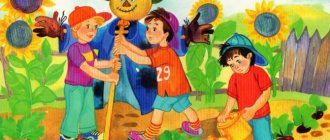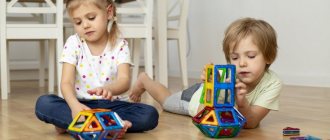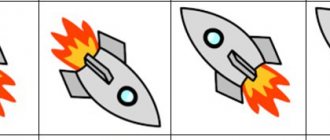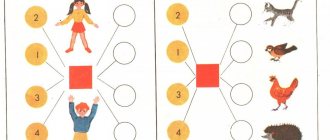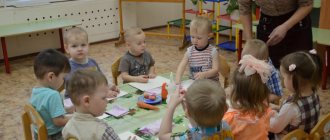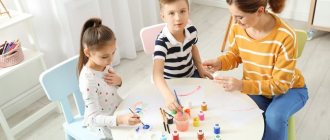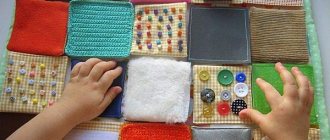Typically, kindergartens teach children 3-4 years old. Working in specialized programs, teachers give young preschoolers there the entire set of knowledge and skills they need. But there are also situations when a child cannot attend this institution or misses a lot due to frequent illnesses. Then the parents take charge of their child’s education themselves. Through systematic developmental activities for children 3-4 years old, even at home, children can learn everything that is appropriate for their age, if you know what and how to teach them.
How educational activities are carried out with children 3-4 years old at home
Homeschooling is a labor-intensive process that requires certain preparation of the parent and the right attitude. To work effectively, you need not only to think through the content of the lessons, but also to awaken the child’s interest in learning. What do you need to know?
Principles of organizing home activities
Any training, home or professional, must be carried out in accordance with the basic principles of pedagogy and take into account the age characteristics of the preschool child. What do you need to know?
- Firstly, for 3-year-old children the leading activity is play. Only by playing can a child be completely immersed in the learning process and firmly grasp the necessary knowledge.
- Secondly, all activities with the child must be systematic. Daily lessons, which are planned in advance, become more difficult as they are learned.
- Thirdly, the child’s activities should constantly change - alternate mental stress with physical exercise and creative tasks.
Conditions for conducting “lessons” for preschool children
At 3 years old, children are already able to concentrate for a long time on an object that interests them, and yet you should not plan too many tasks. The duration of classes for children 3 years old should be no more than 25 minutes, with a mandatory dynamic pause.
Thematic material:
- Educational games for 3 year old boys
- Games for girls 4 years old - educational
It is better to start work when the child has had time to rest and is in a good mood; they usually do it after breakfast or nap, every day at the same time.
While working, nothing should distract the baby’s attention - remove everything unnecessary from the table and out of sight.
Use bright props, handouts and manuals. You can buy them or make them yourself. To avoid losing interest in these learning tools, try not to play with them outside of class.
It’s good if all the exercises in the lesson are united by one plot. This will make it easier to keep the child’s attention.
Take a break from mental stress through physical exercises - dancing to music, walking along a line and an incline, playing with a ball, etc. They need to be included in every lesson.
Objectives and planning
The effectiveness of any work, including pedagogical work, depends on correctly set tasks and a clear plan for their implementation.
The main objectives of developmental activities for children 3-4 years old include the following:
- formation of thinking skills;
- development of motor skills, imagination and creativity;
- improving the sound and semantic aspects of speech, expanding vocabulary;
- formation of ideas about the phenomena and properties of objects, the surrounding world;
- education of personal qualities, teaching norms of behavior.
It is necessary to draw up a plan of developmental activities for children from 3 years old so that different types of activities alternate. Weekly planning will help you understand which exercise should be left, which one should be made more difficult, and which one should be put off for a while.
Mathematical
What should a child learn?
- Count to five.
- Knowledge of a small number of geometric shapes.
- Basic comparison skills.
- The right pairing.
Remember that at three years old children do not have a long fixation on one subject, so classes must be conducted often and little by little (it is better to conduct three classes for 20 minutes than one for an hour).
Learning shapes from drawings
Developmental activities may include the use of cards, puzzles, copybooks and creative tasks.
Cards
At three years old, your baby can still chew paper, so take the time to laminate the cards so that you don’t have to print out a new set for each lesson. Typically, educational games with children are carried out according to the following scheme: You show the child a card with some image (for children it is better to choose the simplest and most understandable drawings) and ask them to repeat the drawing, or to say how many objects are shown in the picture. If you have a set of paired cards, then you can ask the children to play memory-developing games: “find the pair”, “remember the hidden image”, “find the difference” and so on.
Working with cards solves several problems at once
Remember that such activities can be carried out not only at home, but also on the street.
For example, in the warm season, you can make a treasure hunt game: give your child a real pirate map (with the help of ordinary coffee, the paper can be aged for several years), on which educational cards will be indicated with crosses. Explain to your child that he needs to solve the problem in order to be able to move on.
If you have several children, then you can hold a real competition (remember that each of the children should receive their own incentive prize).
If it is cold outside, then a similar competition can be held at home, having previously hidden all fragile objects.
Puzzles
For three-year-old children, it is best to select large pictures consisting of a small number of details.
Educational puzzles for little ones “Farm”
Cut the educational pictures into vertical lines (they should be quite large). The essence of the lesson is for the child to assemble a puzzle and at the same time learn the name, appearance and location of the number on the number line.
Copybooks
This material will help kids develop their hands, as well as write numbers correctly, freely composing numbers from them. Select the copybooks so that the lines in them are large enough and clear.
Coloring pages
Coloring pages with numbers can be given to children from the age of 3.
They are especially loved by children, so try to use these educational materials as often as possible. Due to their compactness, coloring books can be used both at home and outdoors at any time of the year. For three-year-old children, try to choose coloring books that use not only the image of a number, but also its written name (this will help train reading and speech).
Games for children 4 years old
Game 13. “I don’t see and I don’t hear”
This is a great outdoor game for two or more players that children really enjoy. Rules: when the presenter says “I don’t see,” the players run, jump, frolic, but in absolute silence. If someone makes a sound, they lose. If the presenter says “I don’t hear,” then the players can and should make noise, shout, sing, laugh, but stand in one place. Whoever moved lost.
The game is more suitable for the street, so that children can run around and shout to their heart's content without disturbing the neighbors.
Game 14. “Colored paints”
This is a great game for reinforcing knowledge of colors and their shades. It requires a minimum of three participants.
We are sure many parents will remember the rules! You need to draw a line (or lay a rope or cord), on one side of which the leader stands, and on the other, the players. The presenter turns his back, names any color and turns back. Whoever has this color on their clothes easily crosses to the other side, but the rest of the participants must run across before the leader grabs them. Which player he caught takes the place of the leader.
Game 15. “Obstacle Course”
This game will require a little preparation, as you need to create “difficulties” that the children will overcome. It is best to play in a group or even in teams for speed.
Focusing on the interests of the baby, create an obstacle course (chairs to crawl under, a tunnel of pillows, leaves that will save you from a lava river, and so on). The theme can be different, for example, hunting dinosaurs, rescuing a princess from a dragon, a jungle, a pirate island and any other fantasy.
If teams are playing, you can prepare a main prize for the winners and an incentive prize for the losers. But the most important reward in the “Obstacle Course” will be a great mood and a boost of energy!
Game 16. “Again and Again”
An excellent game that develops classification and analysis skills.
You will need cards with pictures of animals, plants, furniture, flowers, transport and anything else that can be classified.
The essence of the game is to lay out all the pictures in front of the child, for example, with furniture and ask them to separate small objects from large ones, then wooden ones from plastic ones, and so on. The more options you have to analyze and compare, the better.
Game 17. “What’s in your mind?”
The purpose of the fun is to develop attention, auditory perception, and speech in a fun and interesting way.
Prepare several simple pictures with different contents and ask your child to choose one, but do not say which one. Then the adult asks questions to figure out which image was chosen, and the child answers either yes or no. For example: “There is a person in this picture?”, “Is there yellow in the person’s clothes?” Then switch roles - who will complete the task faster?
Ready-made plot pictures or images of animals can be purchased at any bookstore or made yourself by cutting them out of magazines.
Game 18. “Mysterious actions”
Two or more people play and need to understand what the presenter is showing with his gestures or actions. For example, an adult pinches his nose, closes his eyes and squats - this is diving into the water. You can wish for any real objects or activities: writing, swimming, sleeping, hammering, and so on. The presenter can prepare possible options in advance and write them down on cards. The participant who named the correct answers faster than the others wins.
Game 19. “Who can do that?”
Another interesting game for speech development. The task is simple - to guess what is being said faster than other players. The presenter describes an object, person or character, for example: “This is a small metal object that makes a thin sound. Such small objects are often hung around the neck of pets” (bell).
The game helps to consolidate any acquired knowledge: about professions, transport, plants, animals, seasons and many other objects and phenomena.
Game 20. “Comparisons”
An adult shows the child two objects and asks them to tell what their similarities and differences are. For example: “Here is a ball and a balloon of different colors, compare them!” The similarity is that both objects are round in shape. Differences: color, material. The more signs the baby names, the better. Gradually make the task more difficult by selecting similar objects, for example, cubes of the same color, but slightly different in size. You can also increase the number of items being compared.
This game perfectly develops attention and improves classification and analysis skills.
Repeat the pattern
Identical pictures
Two identical objects
Game 21. “Questions and answers”
The essence of the game is to answer various questions asked by an adult. These can be either funny questions or educational and reinforcing ones. For example: “Are there thunderstorms in winter?”, “What color is the sun?” or “Why do you need to eat?”
The game develops speech and memory, as well as generalization skills and is suitable for quiet family evenings.
Game 22. “Teams”
An interesting, calm game for speech development. The presenter prepares funny commands in advance: “Sit down, those who love compote,” “Close one eye, those who drank juice today,” and so on. Fun is suitable for meeting new people because it allows you to get to know the interests of new friends and create a fun atmosphere.
Game 23. “Signals”
A very interesting game that develops attention and increases concentration, and also improves memory. The task is simple - the presenter prepares “signals” in advance (any cardboard figures of different colors) and shows them to the children. Each color denotes some action, for example, yellow - stand still, red - sit down, blue - raise your arms up. Show these signals to the players in random order. Gradually make the task more difficult and say commands by showing cards of a different color. The winner is the one who is not confused and follows the signals correctly.
Game 24. “Collecting toys”
An excellent active game that helps not only develop attention and memory, but also quickly clean the room! It is advisable that there are at least two participants in the game to make it a competition.
Take a few items and place them around the room in different places (or just verbalize what to look for). Children need to find all things as quickly as possible and put them in a drawer or basket. The one who comes first wins.
Then make the task more difficult and suggest continuing the search by standing on one leg, clapping, walking single file, or crawling.
What objects were in the picture?
Speech development
Normally, a three-year-old child speaks about 1000 words well and can already speak well, so special attention should be paid to speech development. What can you do?
- Communicate with your child as much as possible, be interested in what he says.
- Perform articulation exercises daily. This will help you place the speech sounds correctly.
- Discuss the story pictures. A collection of fairy tales by Vladimir Suteev is ideal for classes.
- Learn poems and songs. Poetic riddles are a hit with kids.
Speech development is positively influenced by games and exercises that involve fine motor skills , for example:
- all kinds of games with cereals, beans, buttons, sand, shells, pasta, etc.;
- fastening buttons, lacing;
- finger gymnastics;
- origami;
- games with water.
Musical activities help develop speech hearing: singing, guessing familiar sounds, playing musical instruments, guessing songs, singing vowel sounds.
Physical development of the child
The main goal is to make the child stronger, more resilient, dexterous, and teach him to coordinate his movements well. Experts recommend doing the following exercises daily:
- stepping over small obstacles;
- walking on an inclined plane;
- jumping over a drawn line (like playing hopscotch);
- walking on a string placed on the floor;
- jumping forward on both legs;
- jumping from low heights.
It is very useful for three-year-old children to swim, dance, play various ball games, ride a bicycle, and perform various exercises on the children's sports wall. Be sure to teach your child to do morning exercises or do fitness with him.
